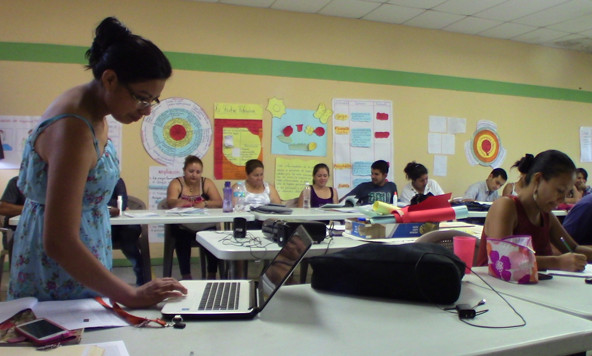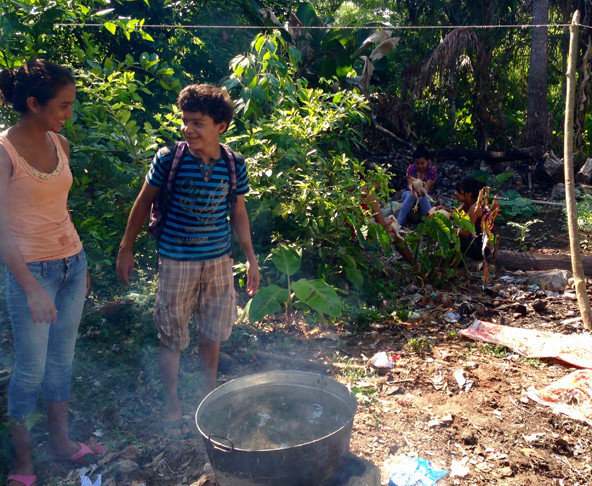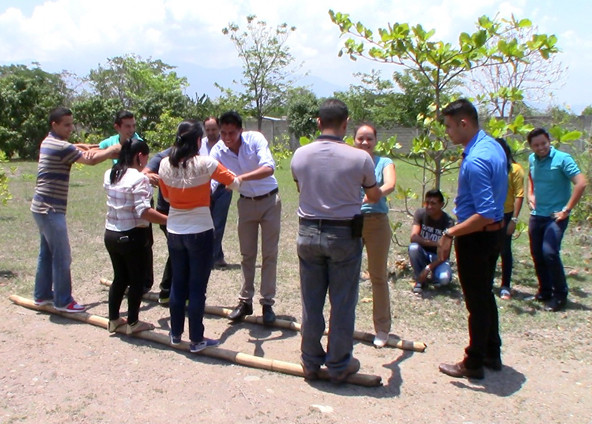When Lucia was working as an assistant in a health clinic in her home community, Sistema de Aprendizaje Tutorial (SAT)—a program designed to help people from rural areas gain a secondary-level education—recruited her to be a teacher. As soon as she started her new job, however, she realized that she was not prepared to teach the topics she was supposed to be covering. While working through a unit on soil science, for example, she felt confident about the scientific content in the curriculum, but knew that she had to defer to her students when it came to discussing the farming activities that would put that science into practice.
To address this challenge, Lucia shifted her role from being a direct instructor to a guide. Knowledge-building became a shared process within the class, and together, Lucia and her students worked to combine theory and practice. The approach worked, and, as Lucia reports, it also complements the way in which SAT trains its teachers. Once shy and afraid to ask questions, Lucia is now an active and vocal participant in the ongoing training she receives from SAT; as a result, that training has become “indispensable.”

Lucia’s shifting role as a teacher, and the opportunities she has to improve her own knowledge through the SAT program, are important not only because of their immediate effects for Lucia and her students but also because of their potential for impact on a larger scale. That’s because they demonstrate a viable solution to at least two major barriers to improving the quality of secondary education in rural settings: 1) teacher availability, and 2) teacher training.
In rural Honduras, as in many rural areas, there is no direct teacher-development pipeline. Many students don’t finish secondary school; those who do often cannot afford to attend university for the requisite formal training. Teachers from urban areas are reluctant to relocate far from their families to take positions in rural communities. And continuous, in-service training has traditionally been difficult to gain for those who do aspire to teach in rural areas. Continued access to a professional learning community (PLC), such as the one offered through SAT, affords teachers the opportunity to reflect on their practice, make sense of their shared experiences, learn new strategies, and connect their work to larger social and cultural contexts.
 Sistema de Aprendizaje Tutorial (SAT) tutors work in small groups with other members of their PLC during trainings. (Photo by Becca Shareff)
Sistema de Aprendizaje Tutorial (SAT) tutors work in small groups with other members of their PLC during trainings. (Photo by Becca Shareff)
In the SAT model, in fact, in-service teacher training both replaces and complements the university preparatory model in supporting the development of a non-traditional set of teachers. To recruit a pool of applicants, SAT advertises on local radio programs and places job announcements in local newspapers. Candidates are required to have completed their secondary schooling and must be working towards a university degree; but, critically, they don’t need to have that degree in hand to begin working with SAT. After an interview and an aptitude test, the individuals selected for the program begin to receive intensive training on the content of the SAT curriculum. This training take place three times a year and is tightly linked with the upcoming units of content the teachers will be teaching (the SAT curriculum covers three “blocks” of content each year). Teachers progress in their training with the same cohort (other individuals from nearby regions who also teaching their same grade), and the process continues through the entire secondary curriculum, paralleling the advancement of their students.
The SAT texts that teachers (called “tutors” there) study are similar to workbooks, in that users are expected to write in them and each tutor has a personal copy. These texts are also interdisciplinary, allowing tutors to develop a wide range of experiences and continually grow in their practice, rather than focusing on developing a fixed identity, for example as a ‘math’ or a ‘language’ teacher. The content also encourages reflection on how morals and service are central to the human experience, allowing tutors to connect their personal opinions and experiences to the topics they are studying. In this way, tutors are constantly challenged to deepen their knowledge of the content, their teaching practice, and their students’ learning needs. (Student texts are similarly oriented.)
Tutors in the SAT program live in the community they work in for a prolonged period of time; as a result, they get to know students and their families. And SAT course projects are explicitly linked to the social, ecological, and agricultural health and development of the communities. In developing projects on land loaned by community members, tutors can assess whether a project is having the desired outcome both initially and over time. For example, if a project for an agricultural science unit focuses on learning about planting patterns, tutors can work to ensure that the project is sustained and develops into viable, ongoing food resources for students and their families. Tutors share the results and impact of students’ project-based studies with their families and provide opportunities for community input in shaping future projects. For example, after a chicken-raising project ended, students asked one tutor if they could raise pigs. Tutor and students then collaborated, with SAT support, to adapt the curriculum and identified the material they would need to learn. The community provided dedicated space and construction supplies. And ultimately, the original biological, engineering, and economics-themed chicken-raising project successfully evolved into one focused on raising pigs.
 Students and tutors engage in a chicken-raising project, combining theoretical and practical knowledge. (Photo by Becca Shareff)
Students and tutors engage in a chicken-raising project, combining theoretical and practical knowledge. (Photo by Becca Shareff)
The results of these innovative, alternative approaches to teaching are promising. The SAT model, when contrasted to the standardized secondary education model in Honduras, is more cost-effective, while increasing students’ learning gains. For example, an impact evaluation found that after two years, children in SAT villages in Honduras outperformed their peers in traditional secondary schools in other rural areas by 45 percent. One plausible explanation for these gains is that SAT schools received more instructional materials, and tutors received more in-service training related to instructional materials. Evidence also suggests that SAT is playing a significant role in improving broader skills in the communities it serves, such as promoting civic responsibility, and empowering girls.
 Tutors practice leading a dynamic exercise to utilize the resources of their environment during Ecosystems training. (Photo by Becca Shareff)
Tutors practice leading a dynamic exercise to utilize the resources of their environment during Ecosystems training. (Photo by Becca Shareff)
While each SAT program must be designed based on the local context, the approach and philosophy behind the model offers potential to address similar barriers and achieve similar impact in other countries and regions. Indicators that SAT is a good candidate for scaling up include a replicable structure, support in training and evaluation by a network of administrators, inexpensive and culturally-sensitive curricular materials, and multi-national acceptance as an official secondary school program. In redefining what it means to be a teacher, SAT is offering a new and promising take on how rural students can access quality secondary education to benefit their communities and improve their lives.
Support SSIR’s coverage of cross-sector solutions to global challenges.
Help us further the reach of innovative ideas. Donate today.
Read more stories by Becca Shareff & Erin Murphy-Graham.

